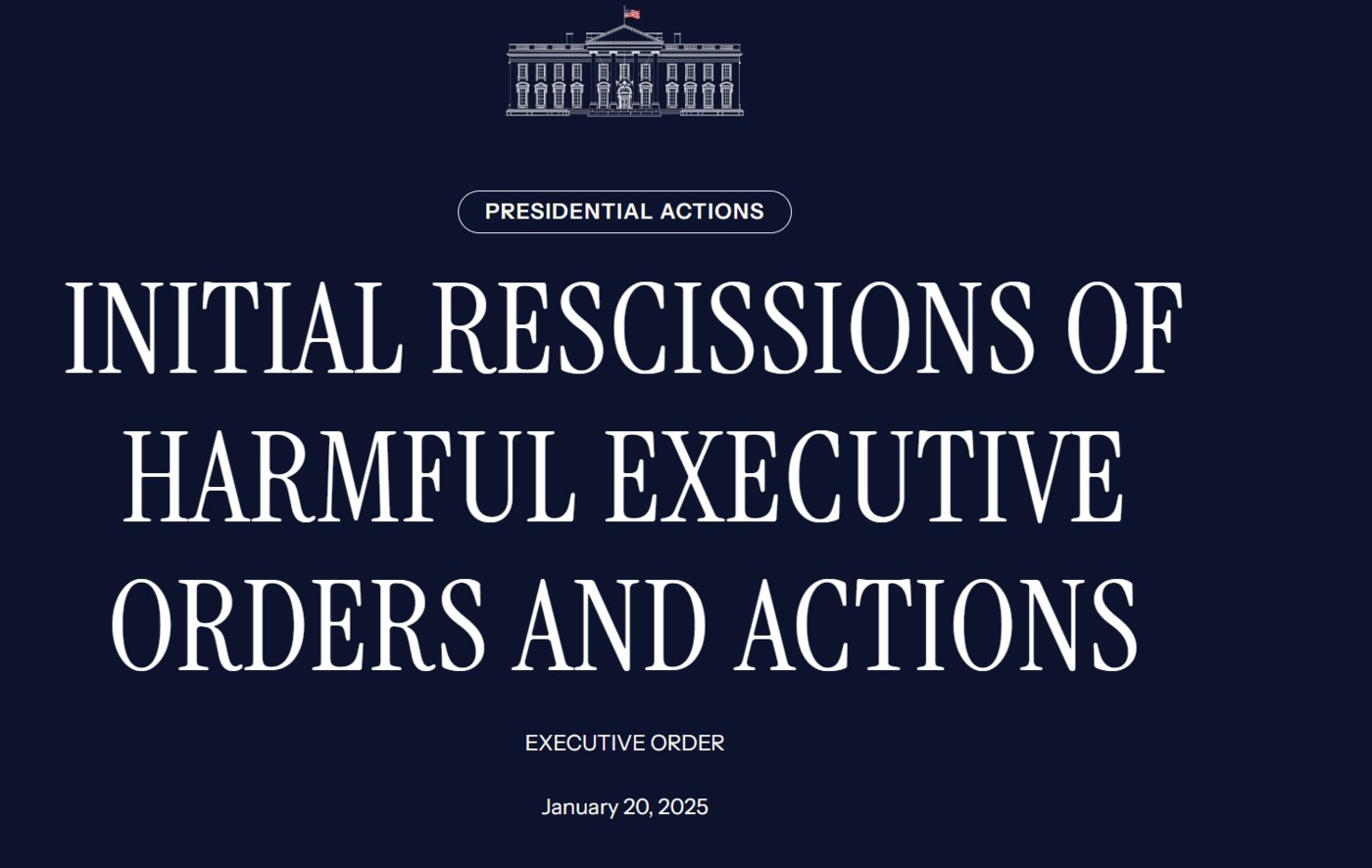
At about 12 noon Eastern Time on January 20 (at about 1 a.m. Beijing time on January 21), Trump was sworn in as President of the United States and delivered an inaugural speech. In the following 10 hours, Trump signed a number of executive orders and made new personnel appointments to some agencies. With the official announcement of cabinet nominations and the unanimous approval of Marco Rubio as Secretary of State by the Senate, the core team of his new administration has gradually taken shape, and Trump 2.0 has officially begun.
On the first day of Trump’s return to the White House, the liquidation of the former Biden administration’s green new policy was already beginning. As the United States declared a national energy emergency, fossil fuels once again returned to center stage.
Great Purge
At about 6:50 pm local time on January 20, Trump signed nine executive orders on the spot under the watchful eyes of many supporters at the Capital One Stadium in Washington, including withdrawing from the Paris Climate Agreement and revoking Biden. There are as many as 78 policies during the period. According to GuShiio.com’s stock market smart APP, they include at least 6 climate policies including establishing a climate change support office to respond to domestic and international climate crises, andAt least four policies, including the Infrastructure Investment and Jobs Act implementing the energy and infrastructure provisions of the inflation reduction bill, directly support policies that promote the rapid development of the U.S. clean energy industry. At the same time, the Biden administration has introduced three restrictive policies involving oil, natural gas and other fossil energy sources have also been lifted.The Biden administration’s Green New Deal has come to an end, the legacy has also been liquidated, and the U.S. climate and energy policies have once again reversed after four years.

Trump cancels 78 Biden administration policies
Since then, Trump has also signed another executive order, as previously announced, requiring a complete cessation of lease sales of offshore wind power and a suspension of approvals, licenses and loans for onshore and offshore wind power projects. previouslyThe wind power industry, which is developing relatively slowly and providing relatively low employment capacity, has also become the first victim of the purge”。
In addition to policy-level liquidation, the reshuffle in the personnel field is also worthy of attention. Among Trump’s final version of cabinet nominations, former New York Rep. Lee Zeldin was nominated as director of the U.S. Environmental Protection Agency (EPA), a nomination that had previously caused widespread controversy because Lee Zeldin had publicly said the climate crisis was overstated and was a well-known climate change skeptic. In terms of appointments in the energy field, according to Zhou Xiaokang, an energy and chemical expert, several cabinet nominations who will have a key impact on U.S. energy policy and industry in the future are Treasury Secretary Scott Bessent, Interior Secretary Douglas Burgum and Energy Secretary Christopher Wright. Judging from their previous resumes and remarks, these important members are all staunch supporters of fossil fuels.
Among them, when Scott Bessent was favored as the new finance minister last year, he announced his 3-3-3 planning goals, including achieving an average annual GDP growth of 3% to reduce the budget deficit to 3% of GDP, and producing an additional 3 million barrels of oil every day. Even at the height of the U.S. shale oil revolution, the oil increase was only about 1.5 million barrels per day. Such a large increase in production plan has not only attracted strong criticism from environmentalists, but also been considered by some professionals. It is an impossible task.
In addition, Douglas Burgum was once the governor of North Dakota, the second largest oil-producing state in the United States. After being nominated, he immediately stated that he would promote the restoration of the dominant position of U.S. oil and natural gas and make U.S. energy great again. At the same time, he will also become the leader of Trump’s newly established National Energy Commission, which is believed to be an important starting point for the new administration to reorganize power in the energy field and break through existing regulations. Christopher Wright, who will lead the Department of Energy, is the founder and CEO of Liberty Energy, an oil service giant. The company is regarded as one of the important promoters of the U.S. shale oil revolution. Christopher Wright himself is also a climate change skeptic, publicly denied the existence of the climate crisis on social platforms in 2023. At the same time, he also criticized the Biden administration’s clean energy subsidy policy, saying that no matter how much money is invested and how many policies are formulated, the energy transformation will not really happen. At a recent Senate hearing, he also said that the top priority after taking office is to expand domestic energy production in the United States and reduce domestic energy costs, especially liquefied natural gas and nuclear energy.
In addition, it is worth noting that Trump announced new appointments to two important agencies in the energy field on his first day of inauguration. David Wright became the new chairman of the Nuclear Regulatory Commission (NRC), which oversees commercial nuclear power plants, nuclear materials, etc., and Mark Christie became the leader of the Federal Energy Regulatory Commission (FERC), which oversees the interstate transmission of electricity, natural gas and oil. These two independent agencies play important regulatory roles in the U.S. energy sector. Previous media reports said that Trump was worried that his energy production increase plans would be hindered by these agencies. It seems that how to reshape the regulatory system to facilitate the implementation of his own policies has also become a major topic at the beginning of Trump’s new term. However, although the two major agencies have changed their coaches one after another, and Republicans have replaced Democrats as new leaders, in practice, especially in FERC, which is closely related to Trump’s highly valued LNG construction approval, the Democratic Party has the majority of votes in decision-making. In terms of numbers, Trump’s energy policy may still encounter obstacles.
Drill, drill
As early as during the campaign, Trump saidWill declare an energy emergency in the United States after taking office, and on the first day of his inauguration,This decree has also been officially implemented。
According to the detailed explanation of the executive order on the White House website, its core purpose isIncrease the supply of energy (especially oil, natural gas and the power supply they bring) to support the development of the country’s manufacturing, transportation, agriculture and defense industries, and reduce the high energy costs faced by enterprises and ordinary consumers.。
Regarding the urgency of entering a state of emergency, the executive order emphasizes that it was the policies of the previous government that pushed us into a national emergency, and that the current energy situation also brings limitations and risks to foreign policy. Only by taking decisive remedial measures to unstable and intermittent (new) energy supplies and increasingly unreliable power grids can this situation be changed.
In terms of specific measures, the decree gives the heads of new government agencies the power to urgently approve a series of processes such as the construction and production of energy projects; in addition, the Director of the Environmental Protection Agency, after consulting with and obtaining the consent of the Minister of Energy, will consider issuing an emergency fuel exemption to allow the release of previously banned E15 gasoline sales; energy infrastructure has also been able to be quickly delivered to bypass strict environmental reviews.
At the same time, Trump also signed an executive order called Unleashing U.S. Energy, whose core is to encourage energy exploration and production, shape the U.S.’s core position in key minerals, and weaken the influence of other countries. In this decree, it is clearly stated thatEliminate regulatory barriers to motor vehicle access, cancel electric vehicle authorization policies, end emissions restrictions in states that restrict sales of fuel vehicles,andConsider eliminating unfair and market-distorting subsidies for electric vehicles to allow consumers to make their own choices。At the same time, the decree also requires an immediate review of the behavior of all institutions that may impose a burden on domestic energy development in the United States, especially oil, natural gas, coal, hydropower, biofuels, key minerals and nuclear energy.
In fact, this series of decrees are clearing the way for Trump’s core energy production increase strategy, namely the so-called Drill, Baby, Drill. In the executive order signed on the first day, releasing Alaska’s extraordinary resource potential was a concentrated expression of Trump’s 2.0 energy ambitions.
Alaska is an oil reserve reserve area in the United States. Due to energy strategic planning and increasing environmental risks in the Arctic, many areas of the state have imposed strict restrictions on oil and gas exploration and production in the past century. During Trump’s first term, he had already promoted the loosening of the oil and gas industry in the region. Although the Biden administration had cancelled the oil and gas leases issued by Trump, it also gave the green light to new oil exploration projects in the state. Overall, Alaska’s oil and gas restrictions have continued to loosen. Obviously, in the Trump 2.0 era, the fate of the state’s oil and gas resources has also reached a decisive moment. Under the new executive order, the Trump administration will efficiently and maximize resources in Alaska and use them for production, prioritize activating its liquefied natural gas potential, and sell these liquefied natural gas to other regions of the United States and allies in the Pacific. At the same time, previous bans on the state’s Arctic National Wildlife Refuge have also been lifted in large numbers.
However, at present, although Alaska Governor Mike Dunleavy and some local communities agree to increase oil and gas production and believe that relevant measures can bring objective benefits and improve residents ‘living standards, the Arctic region is the area with the most concentrated environmental controversy. Local communities and institutions such as the Arctic Village Council strongly oppose oil and gas exploration, and some lawsuits against the new government may also be filed one after another.
Although judging from the many policies released on the first day, oil and gas production will play an important role in the Trump 2.0 era and become the core of differences, controversy and political wrangling, can U.S. oil and gas production really be released as quickly as it wants?
At least judging from recent market feedback, not many people are willing to cast votes of confidence. Liam Mallon, president of the upstream business of ExxonMobil, the world’s largest oil company, once said that without the support of real money or considerable economic benefits, U.S. oil and gas producers would not significantly increase production due to Trump’s coming to power or the introduction of some guiding policies. If restrictions are relaxed, production will be significantly increased. Standard Chartered Bank also pointed out in a previous research report that the current oil production situation in the United States has changed significantly compared with the Trump 1.0 period. In particular, the unique production model of shale oil and the tendency of producers to focus on investment strategies and shareholder returns have determined that its output cannot continue to grow significantly. Therefore, the agency predicts that Trump will not promote a surge in U.S. oil production after taking office.(This article is launchedto GuShiio.com Stock Market Smart APP, author|Hu Jiameng, editor|Liu Yangxue)



